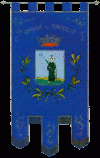Sovicille
 |
Sovicille borders the comuni of Casole d'Elsa, Chiusdino, Monteriggioni, Monteroni d'Arbia, Monticiano, Murlo, Siena.
The name Sovicille is documented as far back as 1004, but the origins of the place probably go back much further. (In 2002 a mosaic from the Roman period was uncovered in the Church of St John the Baptist, and there are several Etruscan relics in the immediate area.)
During the Middle Ages the region found itself on the borders between Siena and Volterra. The Abbey of Serena, some 30 kilometers to the west, was under the control of Volterra, and the land around Sovicille was included as property of the abbey around the year 1000.
A written record of the place survives from 23 April 1123, in which the (by origin Senese) Pope Alexander III identifies it as Sufficille. The name is thought to derive from the Latin words "sub" (under) and "ficinulae/ficus" (small fig tree").
The municipal statutes date right back to the 13th century. The democratically administered Republic of Siena allowed several municipalities, including Sovicille, their own municipal statutes in 1238 (modified in 1293 and then reconfigured, to the format that survives today, in 1303), which included the right to make their own laws.
In 1260 Sovicille was occupied by Florence, but in that year the Florentine armies were defeated at the Battle of Montaperti, whereupon Sovicille reverted to Siena.
In 1333 Sovicille was overrun and burned down by Pisa.
The Medici family purchased the lands of Siena from the Emperor for two million ducats in 1557: this was followed by the abolition of democratic institutions and a return to feudalism. Sovicille became a fief of the Medici and was transformed into an imposing fortress, defending an access point to their newly expanded territories.
After the death of the last of the Medici rulers, power transferred to the Dukes of Lorraine, who remained in control till the end of the 18th century when the entire region was invaded by the French armies of Napoleon Bonaparte.
Map - Sovicille
Map
Country - Italy
 |
 |
| Flag of Italy | |
Italy was the native place of many civilizations such as the Italic peoples and the Etruscans, while due to its central geographic location in Southern Europe and the Mediterranean, the country has also historically been home to myriad peoples and cultures, who immigrated to the peninsula throughout history. The Latins, native of central Italy, formed the Roman Kingdom in the 8th century BC, which eventually became a republic with a government of the Senate and the People. The Roman Republic initially conquered and assimilated its neighbours on the Italian peninsula, eventually expanding and conquering a large part of Europe, North Africa and Western Asia. By the first century BC, the Roman Empire emerged as the dominant power in the Mediterranean Basin and became a leading cultural, political and religious centre, inaugurating the Pax Romana, a period of more than 200 years during which Italy's law, technology, economy, art, and literature developed.
Currency / Language
| ISO | Currency | Symbol | Significant figures |
|---|---|---|---|
| EUR | Euro | € | 2 |
| ISO | Language |
|---|---|
| CA | Catalan language |
| CO | Corsican language |
| FR | French language |
| DE | German language |
| IT | Italian language |
| SC | Sardinian language |
| SL | Slovene language |















